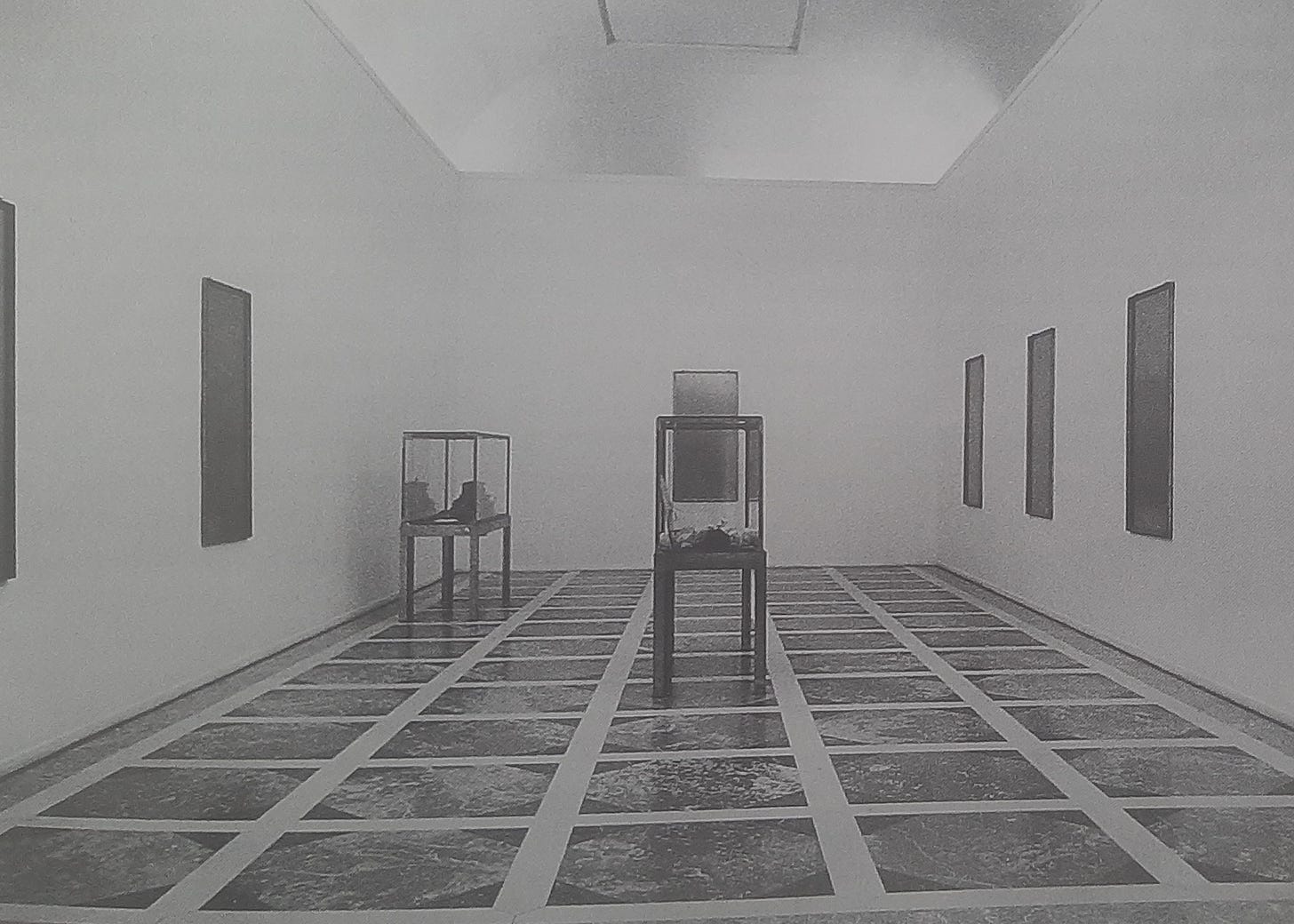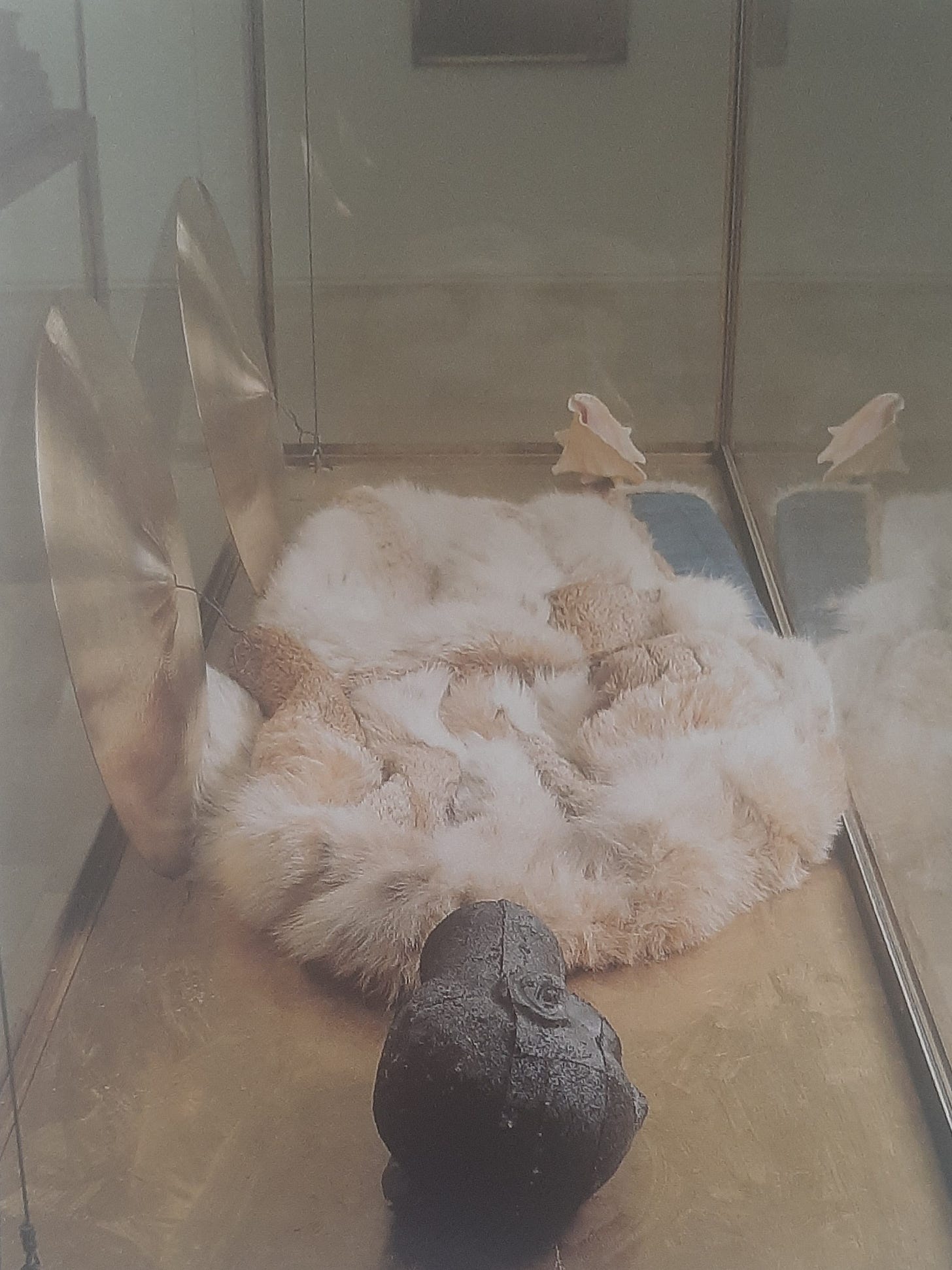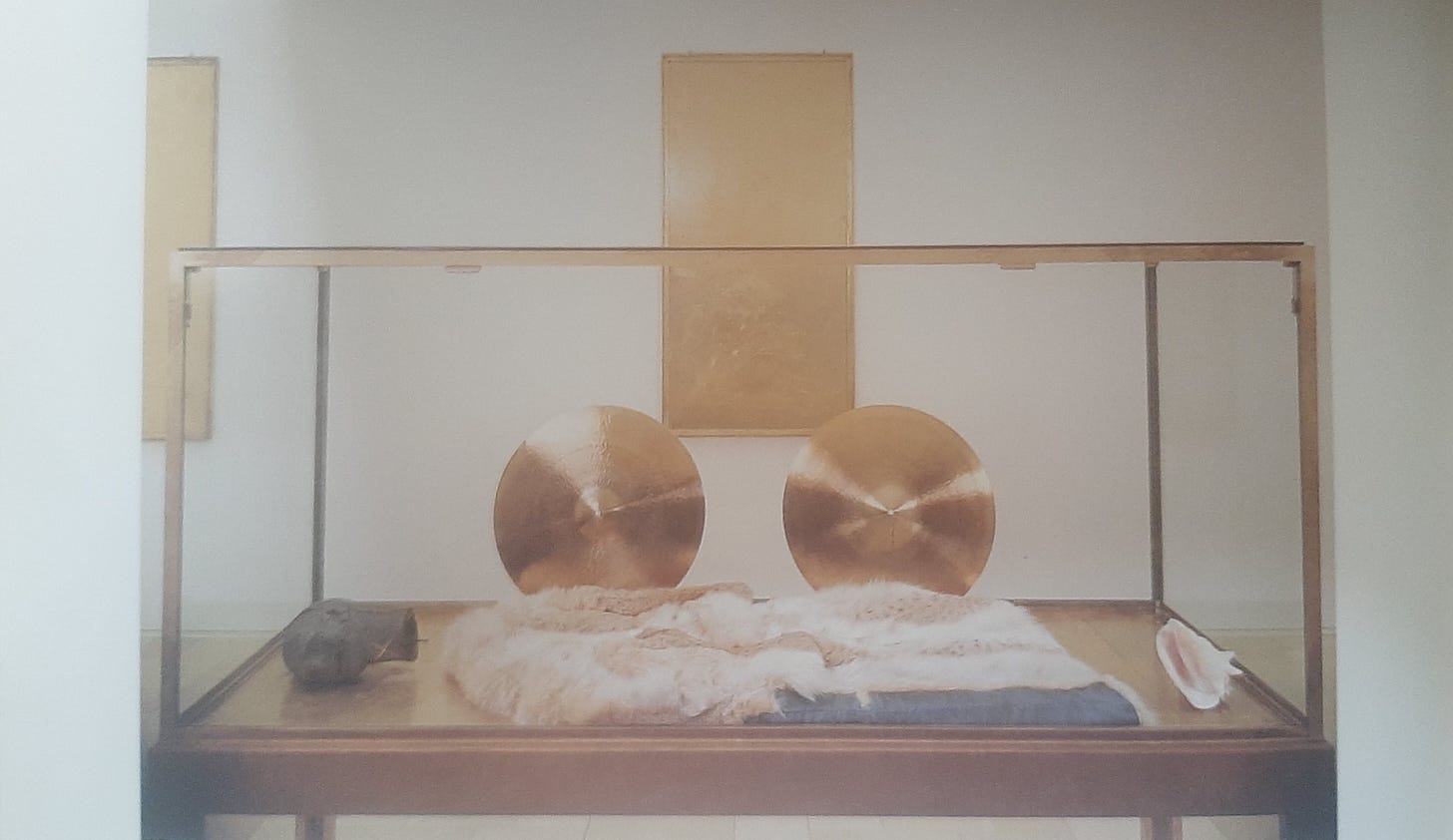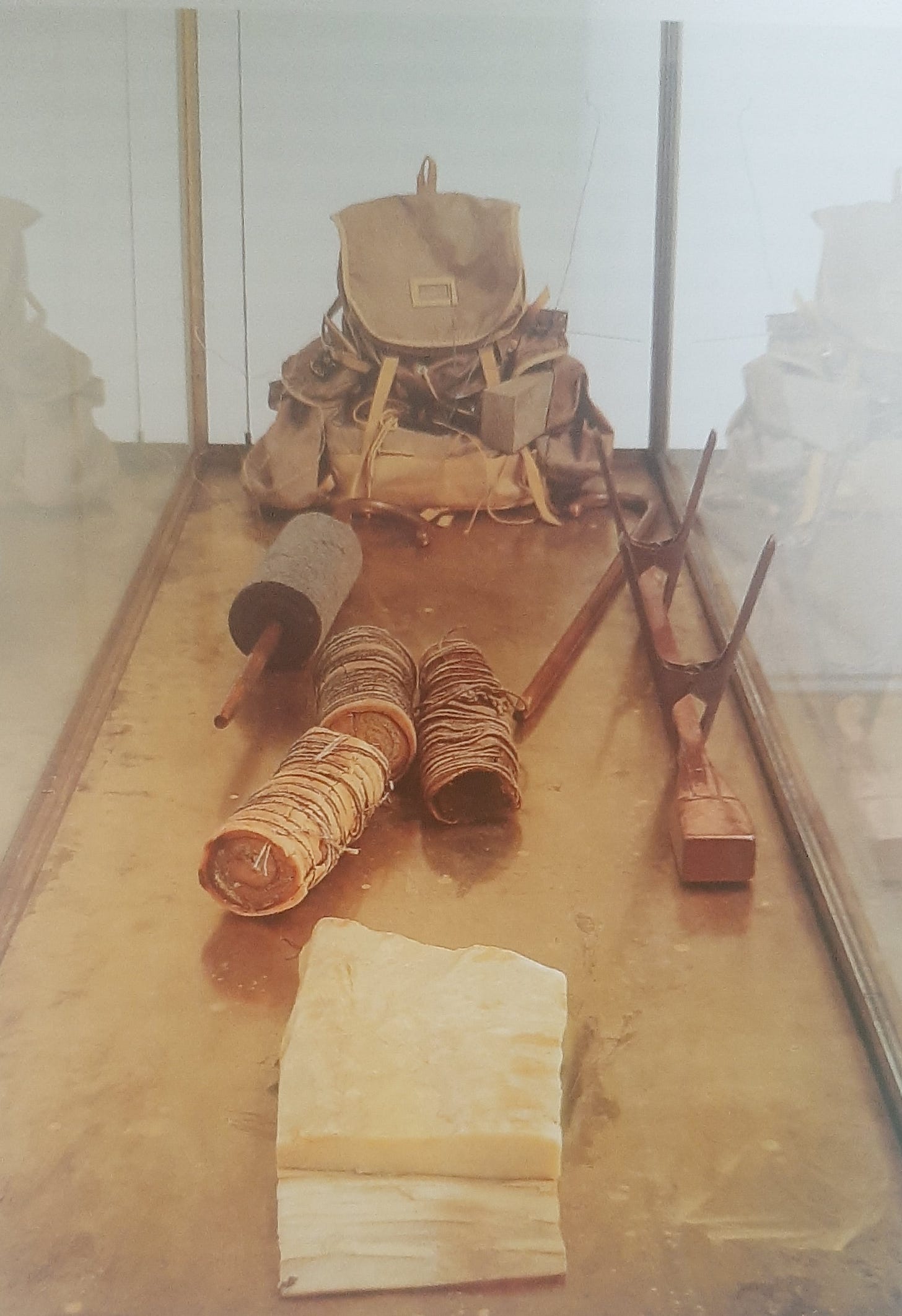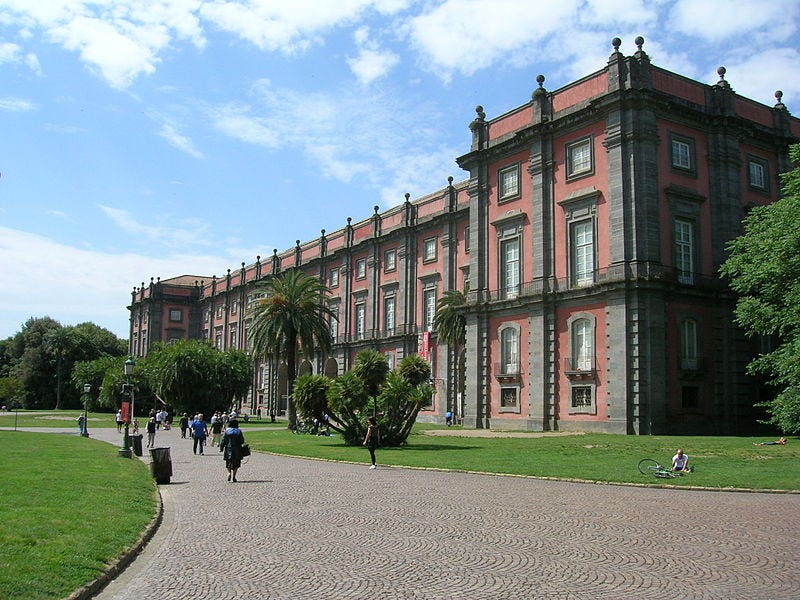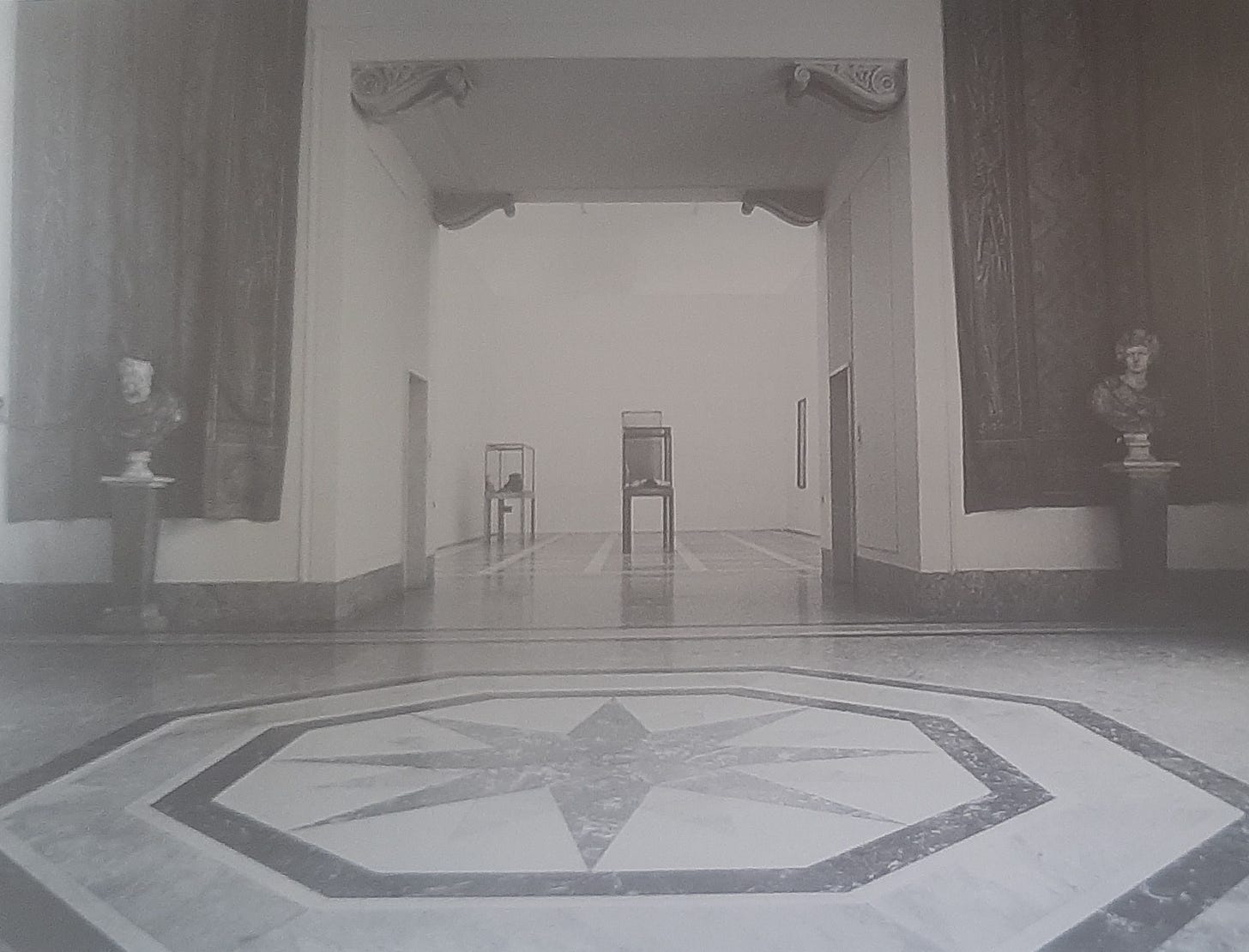Joseph Beuys' Palazzo Regale
The 1985 Exhibition of The Palazzo Regale of Joseph Beuys at the Salone de Camuccini at the Museo de Capodimonte in Naples
Palazzo Regale is the last major work completed by Joseph Beuys before his death in January 1986. In 1985, Beuys specifically designed and installed the work for exhibition at the Salone dei Camucinni at the Museo de Capodimonte in Naples. Palazzo Regale is currently displayed in the K20 collection of the Kunstsammlung Nordrhein-Westfalen in Düsseldorf.[1]
Palazzo Regale consists of two large brass-bound glass vitrines together with seven large brass panels on the walls.[2]
“Palazzo Regale”. Installation in Museo di Capodimonte, Naples. A. Zweite.
The first vitrine contains: a sculptured iron head, first displayed as part of Beuys’ installation Tramstop at the 37th Biennale in Venice (1972),[3], which Beuys associated with Baron Anarcharsis Cloots (1775-1794), a Rhineland aristocrat and revolutionary who was guillotined in the French Revolution;[4] a full-length lynx fur coat with a blue silk lining which Beuys wore during many of his actions; two cymbals from his action Iphigenie /Titus Andronicus in 1969; and a large yellow, white and pink snail shell from Capri representing the horn of Triton, in Greek mythology a son of Poseidon, and used by Beuys in his actions as a musical instrument.[5]
“Palazzo Regale” - Vitrine I. Walter Klein.
“Palazzo Regale” - Vitrine I. Walter Klein.
At the far end of the second vitrine is a rucksack used by Beuys in his joint 1978 action In memoriam George Macunias with Nam June Paik (1932-2006) together with other objects from that action: a wedge of felt in a side-pocket of the rucksack, two bronze walking sticks - with one wrapped in felt - and electric terminals attached to the rucksack. Towards the other end of the vitrine are three dried-up rolls of ham wrapped in string[6] and a piece of bacon fat. Finally, on one side of the vitrine is a long piece of equipment used for laying high-tension wire cast in copper with two copper electrodes attached.
“Palazzo Regale” - Vitrine II - Walter Klein
“Palazzo Regale - Vitrine II. Walter Klein.
In examining the reasons for the appearance, as opposed to the meaning,[7] of Palazzo Regale three inter-related factors seem determining: the physical location of the work; Beuys’ position in the institutional and financial structure of the modern art market; and the fact that the work was created by Beuys in full knowledge of his impending death.
The appearance of the work resembles that of a Pharaoh’s tomb or an early medieval ship grave. The bronze panels, gilded with gold leaf, are highly reflective and create an aura of solemnity and wealth. The objects in the two vitrines, which are finely crafted of iron, are positioned so as to create the image of a human laid out in a funereal setting. In the first vitrine, the object themselves (sculptured head and coat) reinforce this arrangement, while in the second vitrine the objects recall the Celtic custom of burying with the corpse the implements necessary for the voyage into the next world. Beuys, as often in his work, refers to this historical context while at the same time reinterpreting it by substituting objects taken from his life's work as an artist and which are, by virtue of their location in the transparent medium of glass in a museum, designed to ‘nourish’ the visitors after the artist’s death.
The objects in the vitrine not only refer back in a testamentary way to the work of Beuys, but their visual arrangement confers a new and additional meaning for them which refers to the future. In this way, Beuys creates a positive image to coexist with the more sombre obituary elements in Palazzo Regale.
The second element in explaining the visual appearance of Palazzo Regale lies in its location in the Salone de Camuccini at the Museo de Capodimonte in Naples. The work was specially commissioned for the museum with the support of the Fondazione Amelio, the Italian Institute of Philosophical Studies in Naples, and La Soprintendenza Archeologia, Belle Arti e Paesaggio per il communed de Napoli. The museum itself is an imposing building built in the 18th century as a summer residence for the Bourbon kings of Naples in a style reminiscent of Versailles. The work is situated in in a room paved with precious purple marble squares and approached through the Palace’s vestibule furnished with tapestries and craft objects.
Palace of Capodimonte - Wikimedia
“Palazzo Regale” Installation in Museo di Capodimonte - A. Zweite
Beuys reflected the grandeur of the setting for his work, as well as its title, by his choice of materials for the panels on the vitrines. The polished brass panels have been varnished and coated with fragments of gold leaf and reflect the indirect lighting to create a golden soft light. The regal appearance is reinforced by the choice of room which can only be entered from the vestibule and creates an atmosphere of seclusion and tranquillity. Beuys wished to create a visual link between his work and the traditions and history of Naples and the Mezzogiorno.
Simultaneously to this appropriation of the context in which his work was to appear, Beuys introduced to his choice of objects contained in the vitrine a radical critique of the regal tradition as it had been experienced historically. The objects themselves are often the very antithesis of regal objects - lumps of fat and bacon, a simple rucksack and rolls of felt. Instead, they are chosen to awaken visually a new chain of associations in the onlooker freed from the regal associations of historical palace environment. Beuys is thus proclaiming that even in an environment so overladen with historical tradition the human spirit is capable of producing his own environment. As Beuys said in the interview with Michele Bonuoma in Naples in December 1985: “The work contains a very marked symbolic component. I wanted to highlight two elements which are continually present in my work which I think should be included in every human action: on the one hand the sense of grandeur attending the feeling that one is the master of one’s own destiny, and on the other the sense of modesty in all our actions and our work at all times. The whole thing is expressed in an unfussy, very muted way.”[8] This manipulation of visual images to create a complex message is thus explained not only by the theoretical basis of Beuys’ work but also by the very precise circumstances in which the commission was given and undertaken by the artist.
The interrelationship between objective and subjective factors which has been a constant influence in the development of the history of art, further influenced the appearance of Palazzo Regale because the particular status of Beuys in the context of the structures and institutions through which modern artworks are exchanged and valued. By the late 1970s, the works of Beuys ranked with the most expensive of any living artists on the contemporary art market. From November 1979 to January 1980, he had had an individual exhibition at the Guggenheim Museum in New York, the ultimate accolade for a contemporary artist. By 1985, every major modern art museum had or was seeking to obtain a work by Beuys. He achieved this position by carefully placing his works with selected private collectors and museums and by creating an almost mythical aura around both his works and his personality.
When Beuys received the commission for Palazzo Regale in 1985, he was thus at the peak of his career and reputation as an artist. He could conceive and execute the work in the knowledge that he need spare no expense in materials and craftsmanship. Furthermore, he believed that the work was destined for permanent exhibition in a particular room in particular museum without being exposed to sale on the art market. This belief enabled him to create the work with specific reference both in its appearance and meaning to its final location.[9] The position of the vitrines and the panels was precisely arranged by Beuys himself to reflect the particular characteristics of the Salone de Camuccini and the Museum itself, which provided an essential element in the meaning of the work.
Works of art since the Renaissance have increasingly tended to reflect not only the particular stage of an artist’s development but also the social and personal circumstances of the artist. Artists such as Van Gogh have been able to create great works of art even in the most extreme personal circumstances but their work is moulded by these circumstances. Palazzo Regale is in this context a particularly poignant work. It was created by Beuys at the height of his creative powers and his public recognition as the leading living artist for exhibition in a museum located in a region of Italy that held a special appeal for him but, at the same time, he knew that his life was approaching its end. This combination of factors largely explained the appearance of the work. The richness of the materials and craftsmanship involved in the execution of the panels and vitrines, the choice and arrangement of the objects within the room, and the setting in which the work is situated, create an atmosphere of “solemn majesty”[10] which is not only unique in the works of Beuys but also a powerful testament.
Bibliography
Adriani, Götz, Konnertz, W. and Thomas, K. Joseph Beuys: Life and Works. Translated by Patricia Lech, Baron’s, 1979.
Bonuomo, Michele. “Interview with Joseph Beuys”. In Beuys zu Ehren edited by Armin Zweite, translated by John Ormrod, 1986, pp. 618-19.
Kraus, Rosalind E.. “No to … Joseph Beuys.” In Formless. A User’s Guide. Bois, Yve-Alain and Kraus, Rosalind E., Zone Books, 1997, pp. 143-146.
Malvezzi, Kuehn. “Exhibiting Beuys”. Edited by Samuel Korn and Wilfried Kuehn, updated version by Wilfried Kuehn in Joseph Beuys. Parallelprozesse: Katalog zur Ausstellung der Kunstsammlung, NRW, Verlag Schirmer/Mosel, at pp. 148-159.
http://kuehnmalvezzi.com/media/text/KM_Displayer04ExhibitingBeuys.pdf
Rosenthal, Mark. “Joseph Beuys: Staging Sculpture”. Joeseph Beuys : Actions, Vitrines, Environments. Tate Publishing, 2004, pp. 10-135.
Zweite, Armin (ed.). Joseph Beuys: Palazzo Regale. Kulturstiftung der Länder, 1992.
Zweite, Armin. “Palazzo Regale”: Joseph Beuys’s Last Environment.” In Armin Zweite (ed.), Beuys zu Ehren, Städtische Galerie im Lenbachhaus, translated by John Ormrod, 1986, pp. 600-606.
[1] https://www.kunstsammlung.de/en/exhibitions/k20-collection
[2] The panels are “coated in varnish, to which fragments of gold leaf have been added”, Zweite, Beuys zu Ehren, p. 601.
[3] See for details of Tramstop, Adriani et al. at pp. 278-280.
[4] For a detailed explanation of the sculpture and the reasons Beuys in his works referenced Kloots, who “propagated cosmopolitan ideas and committed himself in the spread of Reason.” (41, my tr.), see Zweite, Palazzo Regale 41-43.
[5] See, Zweite, Palazzo Regale at p. 43.
[6] Zweite states that the rolls of bacon recalls Italy, a country with which Beuys had a strong and affectionate connection, 49.
[7] Rosalind Krauss writes perceptively on the work’s meaning: “… since Beuys’s various allegories of the sacred tended to join high and low to articulate the sacrificial figures as an exemplary being catapulted from his position as sovereign into an identification with the lowest of his social subjects. Beuys himself projected this dual identity in one of his last works, Palazzo Regale (1985), a funerary monument organized as an allegorized double self-portrait in which the paraphernalia of the tramp or beggar are laid out in one glass-walled sarcophagus and the regalia of the king or emperor in the other.” No to … Joseph Beuys, At p. 145. See also, Zweite, Palazzo Regale 51-53: “”What “Palazzo Regale” communicates is a paradox: a room-specific work of outstanding clarity, which in both core sections collects heterogeneous artefacts, that encompasses the gamut from the formed and the formless, the valuable and the valueless, the useful and the obsolete, from the durable and the ephemeral or rather from the obvious to the enigmatic and thereby at the same time augments the transparency of the whole through such contradictions and leads to the point of absurdity” (54, my tr.) ad absurdum.
[8] Michele Bonuomo, “Interview with Joseph Beuys”, at p. 619.
[9] Armin Zweite transferred Palazzo Regale to K20 Dusseldorf in 1991. “The installation PALAZZO REGALE does not match the original measurements of the space where it was created in 1985, at the Museo di Capodimonte in Naples. In this divergence from the original, it resembles Armin Zweite’s installation of the piece at the Kunstsammlung Nordrhein Westfalen am Grabbeplatz. Unlike that incarnation, however, the 2010 update adheres to Beuys’s original kinesthetic concept by emphasizing the approach along a central axis from a large entrance hall, though without the Capodimonte’s ascending staircase. The installation is positioned as a space within the space of the Grabbe Halle, recasting the low entryway in the corridor leading to the main room as a portal situation. Thus the white plaster walls become part of the installation, echoing the white plaster walls that Beuys found left over from the previous exhibition in Naples and reused. In their relationship to the high ceiling and eye-catching stone floor, the walls and vitrines as currently positioned also correspond to the Naples show, without literally reconstructing it. Rather, they draw a connection, provisional and consistent with past developments, to the existing spatial characteristics of this station.” Exhibiting Beuys. At p. 152.
[10] Armin Zweite, “Palazzo Regale: Joseph Beuys’s Last Environment,” at p. 600.




